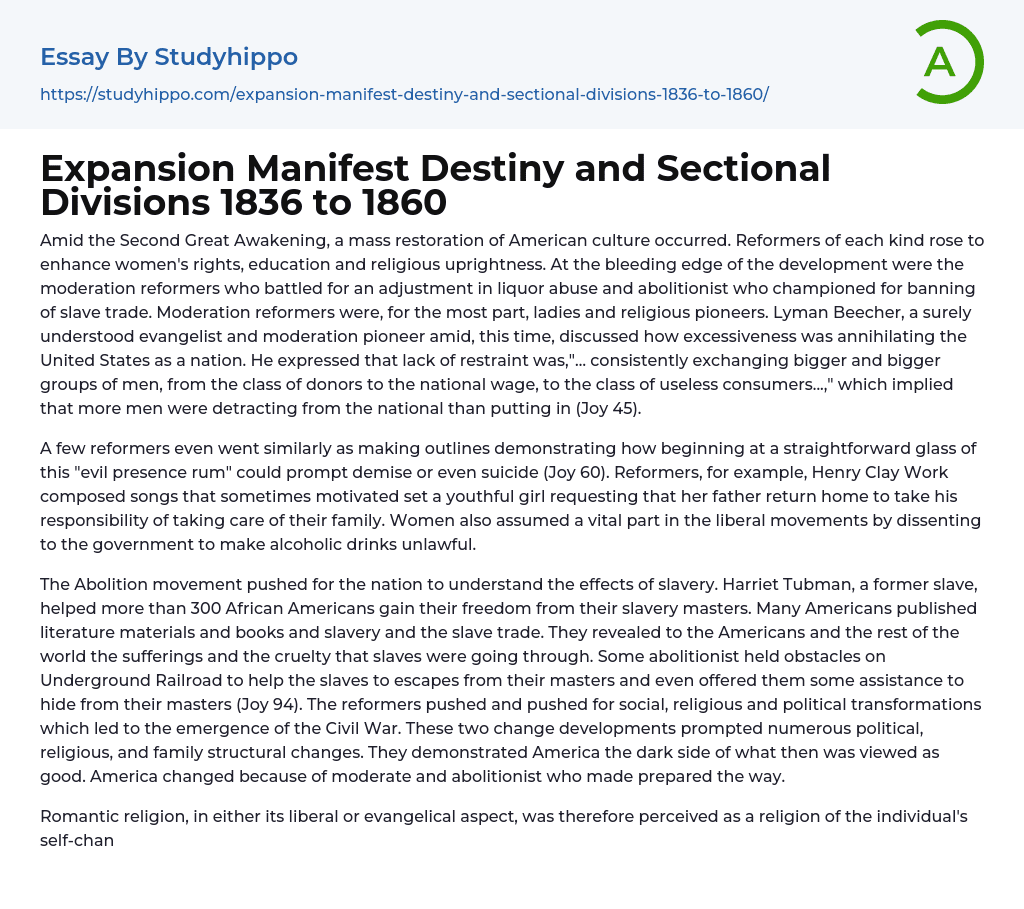

Expansion Manifest Destiny and Sectional Divisions 1836 to 1860 Essay Example
During the Second Great Awakening, there was a significant revival of American culture. Various types of reformers emerged to improve women's rights, education, and religious piety. Leading this movement were the temperance reformers, who fought against alcohol abuse, and the abolitionists, who campaigned for the prohibition of slave trade.
The main advocates for moderation reform were primarily women and religious leaders. One well-known evangelist and leader in the temperance movement, Lyman Beecher, spoke out about the destructive effects of excessive drinking on the United States. He argued that excessive alcohol consumption was causing a shift from productive members of society to unproductive consumers, thus harming the nation (Joy 45). Some reformers even created visual aids, such as charts, to illustrate how something as simple as a glass of alcohol could lead to death or even suicide (Joy 60). Additionally, reformer
...s like Henry Clay Work composed songs that often urged individuals, like a young girl asking her father, to prioritize their responsibilities to their family and return home.
Women played a crucial role in both the liberal movements, advocating against the government's alcohol laws, and the Abolition movement, shedding light on the atrocities of slavery. Harriet Tubman, a former slave, assisted over 300 African Americans in achieving their freedom. Additionally, numerous Americans published literature and books exposing the harsh realities and cruelty faced by slaves and the slave trade.
According to Joy (94), some abolitionists obstructed the Underground Railroad to help slaves escape from their owners and provided them with hiding places. These reformers played a crucial role in advocating for social, religious, and political changes that ultimately triggered the start of the Civil War. Consequently, there were numerous
transformations in politics, religion, and family structures as a result of these two influential movements. They revealed the previously unnoticed flaws in America's perception of goodness. The combined efforts of moderate individuals and abolitionists brought about a transformation in the country.
The perception of Romantic religion, whether in its liberal or evangelical form, was that it was a religion that emphasized the individual's ability to change themselves. Decision-making was seen as central and important. It was also a religion that focused on feelings as a powerful tool of expression. The Second Great Awakening of the 1820s and 1830s is known for its passionate emotions. This period saw experiences of intense catharsis, where deep-seated and powerful emotions were released through singing, expressing regret, feeling anguish, and ultimately finding relief and happiness.
Emotion played a role in the liberal reinterpretation of religion. Unitarianism, often criticized for its intellectualism, was transformed through the passionate preaching of religious ministers such as William Ellery Channing and Henry Ware Jr., who emphasized the importance of the heart in religious experience. Ralph Waldo Emerson was inspired by this type of preaching and incorporated it into his own sermons. It also influenced his depiction of the concept of finding joy and connection with the natural world in his first book, Nature (1836), which became a significant influence in American literature. Transcendentalism, which emerged in the early 1830s, reacted against Unitarianism and its perceived emphasis on reason and exclusion of individual emotions. Many of the early transcendentalists were formerly Unitarian pastors who rejected the restrictive religious doctrines and rituals in favor of more personal and philosophical exploration of the relationships between the self, nature, and the
divine (Joy 100).
The individuals who were part of the Second Great Awakening had a distinct perspective compared to the majority. They stood out because of their privileged position and their focus on personal experience in various fields of knowledge. They not only distanced themselves from organized religion but also from Christianity itself, opting instead for a naturalistic form of spirituality. In some ways, their beliefs aligned with those of the Second Great Awakening, such as emphasizing joyful and extraordinary experiences, valuing inner life and individual spirituality over formal education, and believing that spiritual renewal would bring about societal and moral change (Joy 105). Ultimately, significant transformations occurred in all aspects of American life – politics, society, and religion – between 1836 and 1860.
The rise of Romanticism brought about a deeper comprehension and acknowledgement of human rights, ultimately leading to the eradication of slavery in the United States and other regions globally. This transformation was influenced by both the Transcendentalism movement and the Second Great Awakening, which molded Americans' perspectives on Christian doctrines.
Work Cited:
- Joy, Mark S. American Expansionism, 1783-1860: A Manifest Destiny?. Pearson Education, 2003.
- Acceptance essays
- Age Of Enlightenment essays
- Child Observation essays
- Confucianism essays
- Conscience essays
- Critical Reflection essays
- Destiny essays
- Determinism essays
- Empiricism essays
- Environmentalism essays
- Epistemology essays
- Ethics essays
- Ethos essays
- Existence essays
- Existentialism essays
- Fate essays
- Free Will essays
- Functionalism essays
- Future essays
- Good And Evil essays
- Human Nature essays
- Individualism essays
- Meaning Of Life essays
- Metaphysics essays
- Natural Law essays
- Personal Philosophy essays
- Philosophers essays
- Philosophy Of Life essays
- Political Philosophy essays
- Pragmatism essays
- Reality essays
- Relativism essays
- Teaching Philosophy essays
- Time essays
- Transcendentalism essays
- Truth essays
- Utilitarianism essays
- Afterlife essays
- Atheism essays
- Bible essays
- Buddhism essays
- Christian Worldview essays
- Christianity essays
- Confession essays
- Cosmological Argument essays
- Deism essays
- Devil essays
- Existence of God essays
- Faith essays
- Freedom Of Religion essays



